8 Best Refractometers of 2025 – Reviews & Top Picks
Last Updated on
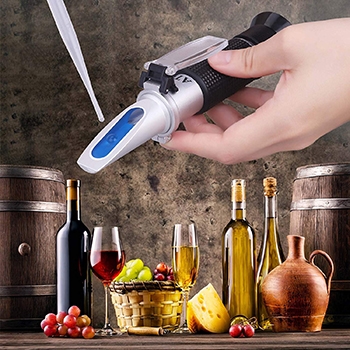
Whether you are a world-class scientist or are just starting to brew your own beer at home, there are a lot of uses for a refractometer. As hobbies that use a refractometer become more popular, the number of different models on the market goes up.
As such, we understand that shopping for one can be a bit overwhelming, so in these reviews, we’ll go over eight of the best refractometers. Hopefully, this resource will ease the anxiety of the shopping experience. Now, let’s shine a light on — or through — these products.

A Quick Comparison of Our Favorites in 2025
| Image | Product | Details | ||
|---|---|---|---|---|
| Best Overall |
 |
Magnum Media Salinity |
|
CHECK PRICE |
| Best Value |
 |
Anpro Brix |
|
CHECK PRICE |
| Premium Choice |
 |
Milwaukee Digital Salinity |
|
CHECK PRICE |
 |
Brew Tapper Dual Scale |
|
CHECK PRICE | |
 |
Ade Advanced Optics Beer & Wine |
|
CHECK PRICE |
The 8 Best Refractometers
1. Magnum Media Salinity Refractometer – Best Overall
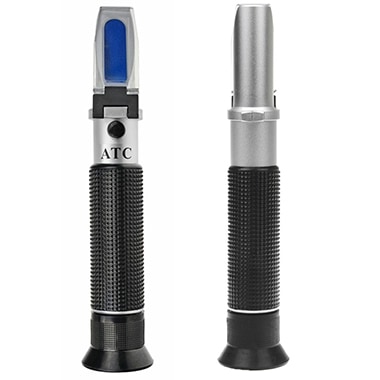
This is a no-frills, portable-use refractometer, made for marine studies and educational purposes. You may be surprised at the power that this battery-free device can offer. It looks like a telescope and is small enough to clip onto you. You know the common saying: Don’t leave home without your refractometer!
The way that this instrument works is brilliant in its simplicity. Once you have acquired your sample of water, place two or three drops of water on the prism. Wait 30 seconds, and then you should have an accurate readout. For the long-term health and accuracy of your refractometer, you will want to clean your instrument immediately after getting your data.
This refractometer provides two different sets of data. It measures specific gravity and parts per scale as it relates to salinity. Not only can you get two measurements in just one test, but this specific instrument is also able to read data points with very low salt concentration. Even better, while the temperature can affect many refractometers, Magnum’s ATC technology (Automatic Temperature Compensation) means that you can take this instrument in and out of different temperature ranges without having to calibrate it each time.
Users are impressed by this inexpensive tool. While it requires more frequent calibration than other instruments, you do get bang for your buck. The customer service team is responsive and friendly as well. Overall, this is a wonderful product from a wonderful company.
This meter also comes with a carrying case. Calibration should always be done with RO water (reverse osmosis).
- Portable
- Accurate
- Two readings at once
- Requires frequent recalibration
2. Anpro Brix Refractometer – Best Value
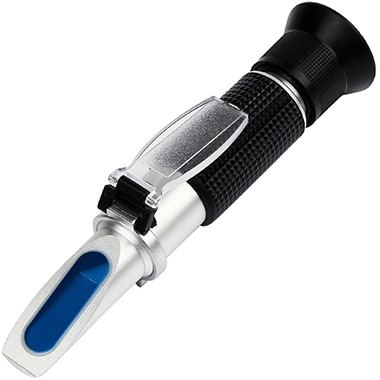
For those of you who are just getting started in the world of homebrewing or if you are on the cusp of the world’s best beer recipe, we have the refractometer for you. Anpro has made this Brix reading instrument specifically for beer brewers. While it has the power and accuracy for the best brewers in the world, it is priced so beginners can pick one up without worry.
This product looks similar to our top pick and is just as portable. However, it is used to measure something else entirely. While our top pick can give you readouts for salinity, this device from Anpro can give you a readout for sugar. The way it is used is exactly the same, the only difference being that instead of testing water, you are testing beer! You will want to clean your instrument after getting the readings in order to keep it in tip-top shape for the long run.
Users are typically thrilled with this item, and many brewers have stated that this refractometer has replaced their hydrometer in the brewing process. It’s not just beer that this tool can help you with; wine and cider makers also love it. The only downside of this tool is that you need to recalibrate it every time you use it for the most accurate reading. We think that this is the best refractometer for the money.
- Easy to use
- Portable
- Accurate
- Needs to be calibrated in between uses
3. Milwaukee Digital Salinity Refractometer – Premium Choice
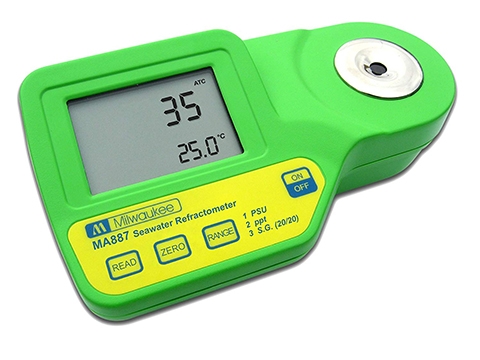
Our premium choice is from Milwaukee, a brand with a great reputation in the world of home improvement and measuring tools. This is the first electronic refractometer on the list, and it certainly does not disappoint. Those who are aquarium enthusiasts will love this device.
This particular instrument is a digital salinity refractometer. It comes with the ATC feature, though most users recommend that you calibrate this tool before every use. Milwaukee has made a refractometer that measures three different data points: practical salinity units (PSU), salinity in parts per thousand (ppt), and specific gravity. As with most refractometers, you will want to make sure to clean this unit between uses and calibrations.
The yellow LED display is easy to read and gives you the data you seek within seconds of testing. It will not only tell you the results of your test but also the temperature at which you tested it. This can help for calibration purposes. To switch between readings, simply press the “read” button and you are good to go.
As mentioned, this instrument is popular with those who are serious about keeping a saltwater aquarium at home. This product is held in high regard, even if some find it frustrating to recalibrate it every time. Your initial purchase will come with calibrating fluid, but you will need to purchase more when you run out.
- Great for saltwater tank enthusiasts
- Three different data points
- Easy to read and use
- Requires constant calibration
4. Brew Tapper Dual Scale Refractometer
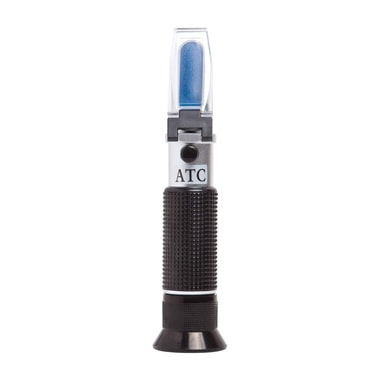
This is another dual-scale refractometer meant for home brewers. This one comes with the standard ATC system that allows for variance in temperature, though for the most accurate readouts, it should be calibrated when changing temperatures.
While advertised toward beer brewers, this instrument can be used for any homemade beverage. Wines and juices can be particularly assisted by this tool.
The two readouts are for Brix and specific gravity. You will get both of these data points at the same time. To use this instrument, place your sample on the strip, and then look through the device. You will have your results within 30 seconds.
Made out of aircraft aluminum, this refractometer should stand the test of time. If anything were to happen to it, though, there is a one-year money-back warranty.
Most homebrewers love this portable tool, while others still swear by a hydrometer. Frequent calibrations are a typical frustration.
- Two readings at once
- Quick results
- Frequent calibrations
5. Ade Advanced Optics Beer & Wine Refractometer
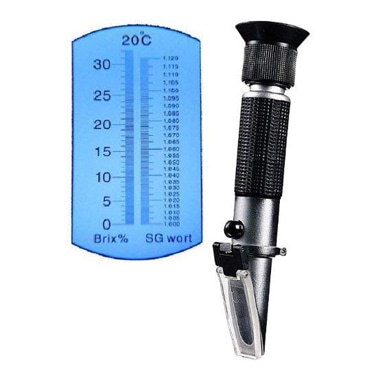
This is a similar device to the others we have listed and is again wonderful for at-home testing for brewers. While the functionality of this remains the same, there are two differences of note. The first is customization. If you want your refractometer to read data points that this instrument is unable to do, you can have one custom-made by Ade Advanced. There is also a warranty, which is two years.
The rest of the functionality is much the same. You will need two or three drops of your sample to get your results in a half a minute or less. Frequent calibration is key for accurate readings.
Homebrewers tend to love this device, though some claim that the accuracy is an issue. We think that more frequent calibration can fix that, but it is possible that there are defective units out there.
- Customizable when ordering
- Two-year warranty
- Requires frequent calibration
- Some devices may be defective
6. Tiaoyeer Brix Refractometer
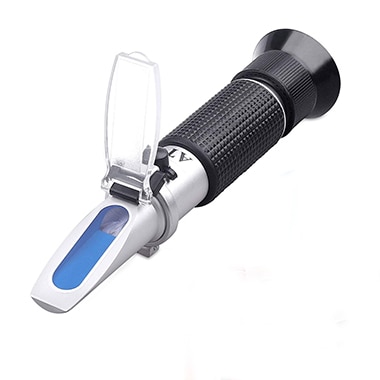
This refractometer from Tiaoyeer has one feature we’ve not seen from the others: It’s waterproof (though we would not recommend submerging it in water). This is useful for the clumsy brewmaster or one who has enjoyed one too many of their own beverages.
Those who bought this product have nothing but good things to say, except for those who were delivered faulty models, though this seems to be a rare occurrence.
- Waterproof
- Faulty product at times
7. Vee Gee Scientific Handheld Refractometer
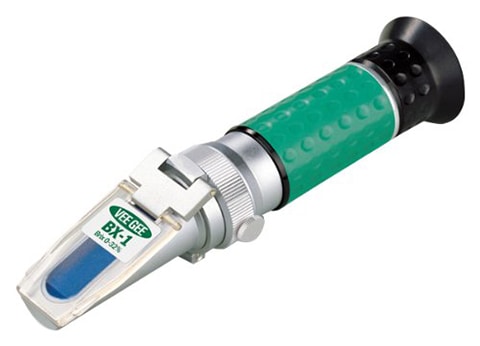
Vee Gee has made a refractometer that is close in performance to the others on this list. However, this refractometer does not come with ATC technology, which is a glaring omission in the design.
Aside from that, it performs in a nearly identical manner as the others. The accuracy is in the same range and the amount of time it takes to get results is comparable.
While this product feels sturdier in the hand because of the materials used, it is hard to justify this tool over any of the others on this list. The performance of the Vee Gee refractometer is on par, but it is in a much different price range. You can get an instrument that will perform just as well for much less.
- Sturdy feel
- Nice rubber grip
- Manual calibration
- Not much better than competition
8. AUTOUTLET Salinity Refractometer
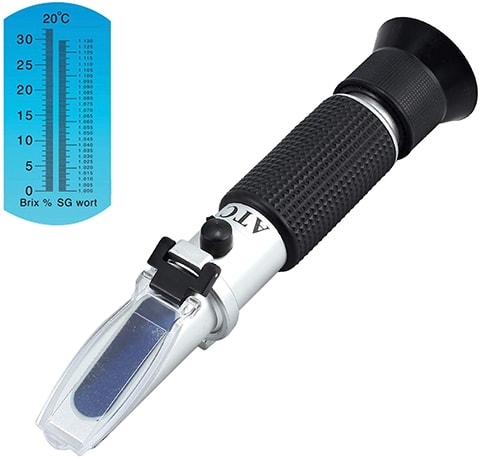
This refractometer is used for salinity and specific gravity, which means it is for marine biologists and aquarium hobbyists. This is quite the precise tool. While others have a hard time measuring content in low percentages, this instrument can measure things as low as 1%. That’s not to say, however, that it is super accurate.
There have been issues with faulty instruments being delivered from the manufacturer. Some users report that the device arrives broken, while others have complained that it is missing pieces.
- Measures to 1%
- Faulty or broken devices

Buyers Guide: Finding the Best Refractometer
There are several hobbies in which buying a refractometer is absolutely crucial. The trick is knowing what kind of refractometer to get for the hobby. It is also important to not mix hobbies while using your refractometer, as you shouldn’t be feeding fish any beer or brewing beer with fish water (gross!). It is easy to remember what you need once you get the hang of it, though.
Brewers and Beverage Makers
For this hobby, a refractometer measuring Brix and specific gravity are what you need. There are plenty on the market, and most of the examples in this list measure both at the same time.
Marine Biologists and Aquarium Hobbyists
For this type of activity, you will want a refractometer that tests the salinity and specific gravity of water. When you test the salinity, you are testing the animal’s environment, so it is important to have confidence in the instrument that you are using. While frequent calibration is recommended for home brewing and beverage making, we strongly advise doing so here.
Warranties
Unfortunately, deliveries don’t always go as planned. Do some research to see how the customer service team is for the refractometer you want to purchase and check the warranty. You might have to pay extra (though typically not), but you will thank yourself in the long run.

Conclusion
We were happy to come up with these refractometer reviews for you, so now if you are ever shopping for this instrument, you’ll have a better idea of what you need. There are quite a few manufacturers of these useful tools, and it is hard to know where to start in the buying process. We hope that these reviews have simplified it a bit for you! Do you have a good idea of which one you want to buy? We strongly stand by our top pick from Magnum Media, but we also love the value pick from Anpro. Whichever you choose, have fun with your hobby!
Looking for more interesting hobbies? Try bird photography!
Table of Contents
- A Quick Comparison of Our Favorites in 2025
- The 8 Best Refractometers
- 1. Magnum Media Salinity Refractometer – Best Overall
- 2. Anpro Brix Refractometer – Best Value
- 3. Milwaukee Digital Salinity Refractometer – Premium Choice
- 4. Brew Tapper Dual Scale Refractometer
- 5. Ade Advanced Optics Beer & Wine Refractometer
- 6. Tiaoyeer Brix Refractometer
- 7. Vee Gee Scientific Handheld Refractometer
- 8. AUTOUTLET Salinity Refractometer
- Buyers Guide: Finding the Best Refractometer
- Conclusion
About the Author Robert Sparks
Robert’s obsession with all things optical started early in life, when his optician father would bring home prototypes for Robert to play with. Nowadays, Robert is dedicated to helping others find the right optics for their needs. His hobbies include astronomy, astrophysics, and model building. Originally from Newark, NJ, he resides in Santa Fe, New Mexico, where the nighttime skies are filled with glittering stars.
Related Articles:
Holy Stone Drone Review of 2024 – Pros, Cons, and Verdict
Ultraviolet Light vs Black Light: What’s the Difference?
Light Waves vs. Sound Waves: The Key Differences
Infrared vs. Thermal Cameras: How Are They Different?
Far Infrared vs Near Infrared: What’s The Difference?
Mottled Duck vs. Mallard vs. Black Duck: What’s the Difference?
Shutter Speed vs Frame Rate: Pros, Cons, & Difference
Oriole vs Goldfinch: How to Tell the Difference



